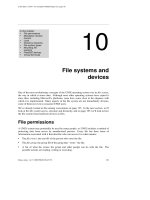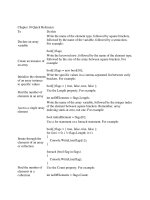Chapter 10 Firewall IPTable
Bạn đang xem bản rút gọn của tài liệu. Xem và tải ngay bản đầy đủ của tài liệu tại đây (1.32 MB, 20 trang )
13/05/2016
Nguyễn Thị Thanh Vân
13/05/2016
Introduction
Characteristic
IPTable Package
Packet Processing
IPTable Table
o Filter
o NAT
o MANGLE
Practice
13/05/2016
2
1
13/05/2016
Firewall for Linux:
o Netfilter and iptables are building blocks of a framework inside
the Linux 2.4.x and 2.6.x kernel.
o This framework enables
• packet filtering,
• network address [and port] translation (NA[P]T) and
• other packet mangling.
Version
o Ipfwadm
o Ipchains
o Iptables
:
:
:
Linux kernel 2.0.34
Linux kernel 2.2.*
Linux kernel 2.4.*
13/05/2016
Stateful packet inspection.
o
o
3
The firewall keeps track of each connection passing through it,
This is an important feature in the support of active FTP and VoIP.
Filtering packets based on a MAC address IPv4 / IPv6
o Very important in WLAN’s and similar enviroments.
Filtering packets based the values of the flags in the TCP
header
o
Helpful in preventing attacks using malformed packets and in restricting
access.
Network address translation and Port translating
NAT/NAPT
Source and stateful routing and failover functions
o
o
13/05/2016
Building DMZ and more flexible NAT enviroments to increase security.
Route traffic more efficiant and faster than regular IP routers .
4
2
13/05/2016
System logging of network activities
Provides the option of adjusting the level of detail of the reporting
A rate limiting feature
Helps to block some types of denial of service (DoS) attacks.
Packet manipulation (mangling) like altering the
TOS/DSCP/ECN bits of the IP header
Mark and classify packets dependent on rules. First step in QoS.
13/05/2016
5
Most Linux already have iptables
Download from:
/>Documentation:
ation/index.html
Install from sources or rpm:
# rpm –ivh iptables-1.2.9-1.0.i386.rpm
# tar xvfz iptables -1.2.9.tar.gz ; ./configure ; make ; make install
Modules to add functionallity to IPtables:
Variour proxy modules, for example ftp and h323
Modules must be loaded into kernel
# modprobe module
# insmod module
Patch-o-Matic (updated and modules)
/>
3
13/05/2016
You can start, stop, and restart iptables after booting by using the
commands:
Starting IP tables: service iptab les start
Stopping IP tables: service iptab les stop
o Restaring IP tables: service iptab les restart
o Checking IP tables status (rulechains): service iptab les status
o
o
To get iptables configured to start at boot, use the chkconfig
command: chkconfig iptab les on
iptables itself is a command which we will see soon.
To show all current rule chains: iptables –-list
To drop all current rule chains: iptables –-flush
All packets inspected by iptables pass through a sequence
of built-in tables (queues) for processing
Three builtin tables (queues) for processing:
1. MANGLE: manipulate QoS bits in TCP header
2. FILTER: packet filtering, has three builtin chains (your firewall policy rules)
o Forward chain: filters packets to servers protected by firewall
o Input chain: filters packets destinated for the firewall
o Output chain: filters packets orginating from the firewall
3. NAT: network adress translation, has two builtin chains
o Pre-routing:
NAT packets when destination address need changes
o Post-routing: NAT packets when source address need changes
4
13/05/2016
5
13/05/2016
Input chain: filters packets destinated for the firewall
Server
(destination)
PC
(source)
PC
(source)
Server
(source)
PC
(destination)
13/05/2016
PC
(destination)
Output chain: filters packets orginating from the firewall11
Forward chain: filters packets to servers protected by firewall
Server
(forward)
PC
(source)
13/05/2016
PC
(destination)
12
6
13/05/2016
Post-routing (NAT OUT): NAT packets when source address need changes
PC
(source)
(172.29.1.5
SNAT
172.29.1.5
203.162.4.54
Routing
Server
(destination)
203.162.4.1
Routing
PC
(source–Internet)
203.162.4.1
DNAT
203.162.4.54
172.29.1.5
Web server
(destination)
172.29.1.5
13
Pre-routing (NAT IN): NAT packets when destination address need changes
13/05/2016
Each firewall rule inspects each IP packet and then tries to identify it
as the target of some sort of operation. Once a target is identified,
the packet needs to jump over to it for further processing
ACCEPT
iptables stops further processing.
o The packet is handed over to the end application or the operating
system for processing
o
DROP
iptables stops further processing.
o The packet is blocked.
o
REJECT
o Works like the DROP target, but will also return an error message to the
host sending the packet that the packet was blocked
--reject-with qualifierQualifier is an ICMP message
7
13/05/2016
LOG
o The packet information is sent to the syslog daemon for logging.
o iptables continues processing w ith the next rule in the table.
o You can't log and drop at the same time ->use tw o rules.
--log-prefix ”reason"
SNAT
o Used to do source netw ork address translation rew riting the source IP
address of the packet
o The source IP address is user defined
--to-source <address>[-<address>][:
DNAT
o Used to do destination netw ork address translation. ie. rew riting the
destination IP address of the packet
--to-destination ipaddress
MASQUERADE
o Used to do Source Netw ork Address Translation.
o By default the source IP address is the same as that used by the firew all's
interface
[--to-ports
13/05/2016
16
8
13/05/2016
S
S
S
D
d
13/05/2016
17
9
13/05/2016
• We try to define a rule that will accept all packages on interface eth0 that
uses TCP and has destination address 192.168.1.1.
• We first define the MATCH criterias:
Use def ault f ilter table (absense of –t )
Append a rule to end of INPUT chain (-A INPUT )
Match on source address can be any 0/0 address (-s 0/0 )
Input interf ace used is eth0 (-i eth0 )
Match on destination address 192.168.1.1 (-d 192.168.1.1)
Match Protocol TCP (-p TCP )
If all matches is f ulf illed, then jump to ACCEPT chain. (-j ACCEPT )
• iptables -AINPUT -s 0/0 -i eth0 -d 192.168.1.1 -p TCP -j ACCEPT
10
13/05/2016
Allow ping request and reply
o iptables is being configured to allow the firewall to send ICMP
echo-requests (pings) and in turn, accept the expected ICMP echoreplies.
iptables -A OUTPUT -p icmp --icmp-type echo-request -j ACCEPT
iptables -A INPUT -p icmp --icmp-type echo-reply -j ACCEPT
Put limit on ping to prevent flood pings
iptables -A INPUT -p icmp --icmp-type echo-request \
-m limit --limit 1/s -i eth0 -j ACCEPT
–m limit sets maximum number of SYN packets
o iptables is being configured to allow the firewall to accept
maxim 5 TCP/SYN packeds per second on interface eth0.
iptables -A INPUT -p tcp --syn -m limit --limit 5/s -i eth0 -j ACCEPT
o If more than 5 SYN packets per second, the packets are dropped.
o If source/destination sence dropped packets, it will resend three
times
o If drops continue after 3 reset packets, source will reduce packet
speed.
11
13/05/2016
Allow both port 80 and 443 for the webserver on inside:
iptables -A FORWARD -s 0/0 -i eth0 -d 192.168.1.58 -o eth1 -p TCP \
--sport 1024:65535 -m multiport --dport 80,443 -j ACCEPT
The return traffic from webbserver is allowed, but only of
sessions are opened:
iptables -A FORWARD -d 0/0 -o eth0 -s 192.168.1.58 -i eth1 -p TCP \
-m state --state ESTABLISHED -j ACCEPT
If sessions are used, you can reduce an attack called half
open
Half open is known to consume server all free sockets (tcp stack
memory) and is senced as a denial of service attack, but it is not.
Sessions are usally waiting 3 minutes.
12
13/05/2016
Define fast input queue:
iptables -A INPUT -i eth0 -d 206.229.110.2 -j fast-input-queue
Define fast output queue:
iptables -A OUTPUT -o eth0 -s 206.229.110.2 -j fast-output-queue
Use defined queues and define two icmp queue’s:
iptables -A fast-input-queue -p icmp -j icmp-queue-in
iptables -A fast-output-queue -p icmp -j icmp-queue-out
Finally we use the queue’s to define a two rules:
iptables -A icmp-queue-out -p icmp --icmp-type echo-request \
-m state --state NEW -j ACCEPT
iptables -A icmp-queue-in -p icmp --icmp-type echo-reply -j
ACCEPT
RedHat based distributions:
Other distributions uses:
/etc/sysconfig/iptables
There is no specific favourite place, one is:
/etc/rc.d/rc.firewall
And maby this is the most common is:
/etc/init.d/rc.firewall
RedHat/Fedora's iptables Rule Generator:
There are three iptable commands:
lokkit
iptables
(The kernel insert rule command)
iptables-save > rc.firewall.backup
iptables-restore < rc.firewall.backup
In RedHat/Fedora you can also:
service iptables save
13
13/05/2016
Filter table
o Input
o Output
o Forward
NAT table
o Post-routing (NAT OUT)
o Pre-routing (NAT IN)
Mangle table
13/05/2016
27
Allow services:
- Web - HTTP
- Ssh
Deny:
- ICMP
- Smtp
14
13/05/2016
http request
Ping
http reply
Server
(forward)
PC
(source)
PC
(destination)
default route (allow forward packet)
sysctl -w net.ipv4.ip_forward=1
Configure:
iptables -A FORWARD –d <Ip_des>.... ACCEPT
PC source, destination: Gateway side
13/05/2016
30
15
13/05/2016
MÔ HÌNH YÊU CẦU
publish web server
172.16.1.3
16
13/05/2016
Publish services:
Web on 172.16.1.3,
Mail on 172.16.1.4
Using port
17
13/05/2016
Proxy:
o tăng tốc nhờ cache
o rule giới hạn truy cập net
Firewall: security
o chia sẻ kết nối net nhờ NAT out -> ko hiệu quả:
• ko tăng tốc,
• ko rule giới hạn truy cập net
kết hợp:
o Packet tới firew all, firew all redirect tới proxy (8080)
o -> client ko cần config IP Proxy
o ->- tăng tốc - security - rule
o config:
• squid.conf ( transparent): http_port 8080 transparent
• Iptable: iptable -t -A nat PREROUTING -i eth1 -p tcp --dport 80 -j REDIREC --to-port
8080
• -> khi client cần truy cập đến port 80 trên eth1 của firewall sẽ bị chuyển tới proxy 8080
o check: stop squid: đóng port 8080 -> client ko truy cập ra net được netsat -an |
grep 8080
13/05/2016
36
18
13/05/2016
6. CẤU HÌNH IPTABLES
* MANGLE
•Sử dụng Mangle ta có thể thay đổi cấu trúc IP Header của 2
trường TOS(8 bits) và TTL(8 bits)
-j TOS --set-tos
Minimize-Delay 16 (0x10)
Maximize-Throughput 8 (0x08)
Maximize-Reliability 4 (0x04)
Minimize-Cost 2 (0x02)
Normal-Service 0 (0x00)
-j TTL --ttl-set <value 0-255> (Set TTL)
--ttl-dec <value 1-255> (Decrement TTL)
--ttl-inc <value 1-255> (Increment TTL )
37
6. CẤU HÌNH IPTABLES
* MANGLE
+ tos :
# iptables -A mangle -o eth0 -j DSCP --set-dscp 0x20
38
19
13/05/2016
7. XÂY DỰNG MÔ HÌNH DỰ PHÒNG
* Các gói phần mềm sử dụng :
- Heartbeat : STABLE-2.1.4.tar.bz2
- Contrack-tools : conntrack-tools-0.9.8.tar.bz2
Heartbeat : tạo 1 ip ảo và trao đổi ip ảo giữa 2 máy. các file
cấu hình sau nằm trong thư mục /etc/ha.d
- File haresource khai báo 2 ip ảo
- File authkeys dùng để xác thực giữa 2 firewall
- File ha.cf dùng để cấu hình log file, udpport, node, keep alive,
dead time , auto_failback
Contrack-tools : Theo dỗi bảng trạng thái giữa 2 firewall có
thể xóa các trạng thái chỉ định và đồng bộ 2 bảng trạng thái
giữa 2 firewall. File cấu hình nằm trong /etc/conntrackd/
39
20









